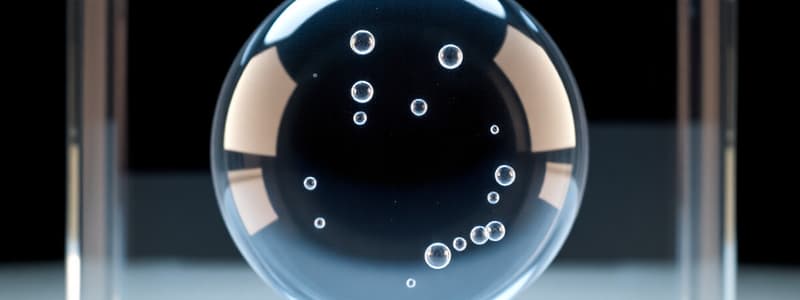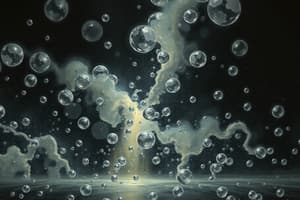Podcast
Questions and Answers
Qual es le categorisation del materia que non pote essere divise in substantias plus simple?
Qual es le categorisation del materia que non pote essere divise in substantias plus simple?
- Solutio
- Elemento (correct)
- Compuesto
- Mistura
Que representa le posicione de un elemento in le tabella periodica?
Que representa le posicione de un elemento in le tabella periodica?
- Le numero atomico (correct)
- Le gruppo
- Le massa atomica
- Le periodo
In le structura atomica, donde se trova le protones?
In le structura atomica, donde se trova le protones?
- In le nucleo (correct)
- In le spatio inter-atomico
- In le orbite
- In le nube electronica
Qual es le correct formula pro calcular le massa percentuale de un composto?
Qual es le correct formula pro calcular le massa percentuale de un composto?
Qual es le characteristic principal de un mistura?
Qual es le characteristic principal de un mistura?
Which statement about matter is accurate?
Which statement about matter is accurate?
What primarily determines the position of an element in the periodic table?
What primarily determines the position of an element in the periodic table?
In atomic structure, where are electrons primarily located?
In atomic structure, where are electrons primarily located?
Which calculation would you use to find the mass percent of an element in a compound?
Which calculation would you use to find the mass percent of an element in a compound?
What distinguishes a mixture from a pure substance?
What distinguishes a mixture from a pure substance?
Flashcards
Tabella Periodic
Tabella Periodic
Un schema che organiza le elementos chimic.
Estructura Atomic
Estructura Atomic
Le structura de un atomo, con nucleo e electronos.
Ubicación Atomic
Ubicación Atomic
Le position de un elemento in le tabella periodic.
Calculos Chimic
Calculos Chimic
Signup and view all the flashcards
Materia
Materia
Signup and view all the flashcards
What is the periodic table?
What is the periodic table?
Signup and view all the flashcards
Location on the periodic table
Location on the periodic table
Signup and view all the flashcards
Atomic structure
Atomic structure
Signup and view all the flashcards
What is matter?
What is matter?
Signup and view all the flashcards
Atomic Number
Atomic Number
Signup and view all the flashcards
Study Notes
Matter
- Pure substances contain only one type of matter; elements or compounds
- Mixtures contain multiple elements or compounds
- Compounds are two or more types of atoms bonded together
- Elements are the smallest units of matter; atoms of the same type
- Atoms in an element cannot be broken down physically or chemically
Periodic Table
- Elements arranged by increasing atomic number
- Differentiated by the number of protons in the nucleus
- Three types of elements: metals, nonmetals, and metalloids
- Metals lose valence electrons, are malleable, ductile, have luster, and conduct heat/electricity
- Nonmetals gain valence electrons, are brittle, and do not conduct heat/electricity
- Metalloids have properties of both metals and nonmetals
- Grouped by columns (groups) and rows (periods)
- Elements in the same group have the same number of valence electrons and similar properties
- Group 1 (alkali metals) have one valence electron, are highly reactive
- Group 2 (alkaline earth metals) have two valence electrons, are highly reactive
- Transition metals in the middle, multiple charges, colored ionic compounds
- Group 17 (halogens) have seven valence electrons, low melting/boiling points, not very soluble in water
- Group 18 (noble gases) have eight valence electrons, very unreactive, mostly gasses
Atomic Structure
- Protons and neutrons are in the nucleus (positively charged)
- Electrons are outside the nucleus
- Protons = atomic number
- Protons + neutrons = atomic mass
- Atomic mass - atomic number = neutrons
- Neutral atoms have equal number of protons and electrons
Atomic Structure and Location
- Atoms are mostly empty space
- Electrons are in different energy levels (further = higher energy)
- First energy level holds 2 electrons, second holds 8, third holds 18
- Energy levels contain orbitals
- Electrons absorb energy to move to a higher energy level (excited state)
- Electrons release energy (light) when returning to a lower energy level (ground state)
Calculations
-
All non-zero numbers are significant
-
Zeros between two non-zero numbers are significant
-
Zeros at the end of a number only significant if decimal present
-
Exact numbers have infinite significant figures
-
Multiplication/division: answer has same number of significant figures as the least precise measurement
-
Addition/subtraction: answer has the least precise place value of the measurements
-
Density = mass/volume (g/mL or g/cm³)
-
Percent error = |(measured-actual)/actual| x 100
-
Atomic mass is average across all isotopes of an element (different versions with same number of protons but different neutrons)
Studying That Suits You
Use AI to generate personalized quizzes and flashcards to suit your learning preferences.



